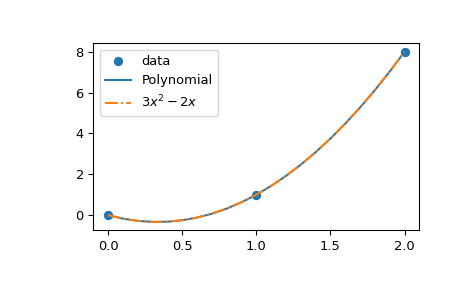lagrange#
- scipy.interpolate.lagrange(x, w)[source]#
Return a Lagrange interpolating polynomial.
Given two 1-D arrays x and w, returns the Lagrange interpolating polynomial through the points
(x, w).Warning: This implementation is numerically unstable. Do not expect to be able to use more than about 20 points even if they are chosen optimally.
- Parameters:
- xarray_like
x represents the x-coordinates of a set of datapoints.
- warray_like
w represents the y-coordinates of a set of datapoints, i.e., f(x).
- Returns:
- lagrange
numpy.poly1dinstance The Lagrange interpolating polynomial.
- lagrange
Notes
The name of this function refers to the fact that the returned object represents a Lagrange polynomial, the unique polynomial of lowest degree that interpolates a given set of data [1]. It computes the polynomial using Newton’s divided differences formula [2]; that is, it works with Newton basis polynomials rather than Lagrange basis polynomials. For numerical calculations, the barycentric form of Lagrange interpolation (
scipy.interpolate.BarycentricInterpolator) is typically more appropriate.References
[1]Lagrange polynomial. Wikipedia. https://en.wikipedia.org/wiki/Lagrange_polynomial
[2]Newton polynomial. Wikipedia. https://en.wikipedia.org/wiki/Newton_polynomial
Examples
Interpolate \(f(x) = x^3\) by 3 points.
>>> import numpy as np >>> from scipy.interpolate import lagrange >>> x = np.array([0, 1, 2]) >>> y = x**3 >>> poly = lagrange(x, y)
Since there are only 3 points, the Lagrange polynomial has degree 2. Explicitly, it is given by
\[\begin{split}\begin{aligned} L(x) &= 1\times \frac{x (x - 2)}{-1} + 8\times \frac{x (x-1)}{2} \\ &= x (-2 + 3x) \end{aligned}\end{split}\]>>> from numpy.polynomial.polynomial import Polynomial >>> Polynomial(poly.coef[::-1]).coef array([ 0., -2., 3.])
>>> import matplotlib.pyplot as plt >>> x_new = np.arange(0, 2.1, 0.1) >>> plt.scatter(x, y, label='data') >>> plt.plot(x_new, Polynomial(poly.coef[::-1])(x_new), label='Polynomial') >>> plt.plot(x_new, 3*x_new**2 - 2*x_new + 0*x_new, ... label=r"$3 x^2 - 2 x$", linestyle='-.') >>> plt.legend() >>> plt.show()
